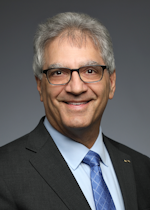In 1953, my dad made a deal that changed the course of our family forever. When Ramiz “Ray” Cohlmia arrived home from serving in the Korean War, he had a very clear idea of how he could continue to serve others. He wanted to become a dentist because he understood the connection between the mouth and body, and he believed it had the most incredible ability to change people’s lives.
There was only one problem: he needed to finish his undergraduate degree, but he had flunked out of two universities before the war. Although he was one of the few in his family to graduate high school and attend college, his first attempts at college netted him a failing grade point average.
But my dad was undeterred. He always said, “Obstacles are what you see when you take your eyes off your goal. And obstacles are the only thing you see when you don’t have a goal.”
Armed with a dream, and courtesy of the G.I. Bill, he met with Dean Hamilton at Southwestern Oklahoma State University and told him he wanted to be a dentist. Dean Hamilton laughed. My dad made his move and asked, “If I earn straight A’s from now on, will you support me?” Intrigued, Dean Hamilton said he would.
Related reading
Channel your inner Gandhi: The power of patients (and patience)
Dentistry is alive: Push through and thrive in the COVID cloud
Sure enough, my father made straight A’s. He earned his degree—and a steak dinner from Dean Hamilton. After that, he was on to Baylor Dental School. In 1959, my dad opened his practice in Oklahoma City. He made everyone he met feel like he had waited his entire life for them to walk through his door. He never turned away a patient in need, and he never let anyone leave in pain. If they couldn’t pay, they didn’t. And still he thrived as a practice owner. He had a house and two cars and said that was all he needed. He practiced dentistry until he retired in 2016 at age 87.
One shared journey, multiple pathways
Today, my dad has left quite a legacy: my extended family includes a lot of cousins and relatives who have entered dentistry, and the number of dentists in our family continues to grow. Though we share a profession, my loved ones have chosen different paths. We don’t all practice in the same specialty, we’re not all in the same city, nor do we practice in the same setting. My oldest son is a practice owner who loves the clinical and business aspects of dentistry in equal measure. My middle son works in a dental support organization (DSO) and devotes his entire day to seeing patients.
Our family could be considered a case study for what the data indicate about the future of the dentist workforce. The ADA Health Policy Institute reveals the changing demographics of practitioners (younger and more diverse than those of previous generations), along with other factors such as the COVID-19 pandemic, are accelerating a shift in practice modality trends.
The data show group practices continue to grow as solo practice and ownership declines. In fact, practice ownership decreased from 84.7% in 2005 to 73% in 2021, and solo practice dropped 20% since 2001. At the same time, the percentage of practitioners working for DSOs has increased, as 10.4% of US dentists were affiliated with DSOs in 2019, up from 8.8% in 2017. This momentum is expected to build, especially considering that the number of dental school seniors who plan to join a DSO more than doubled from 2005 to 2020, according to the 2020 American Dental Education Association Survey of US Dental Schools.
Dentistry has changed tremendously in the decades since my father began his career. Today’s dentists have more practice options than ever before and greater opportunities to build the careers they want. Whether they choose to own their own practice or work at a DSO, there is room for all of us who work in the service of others and change people’s lives through dentistry.
The “right way” to practice is whatever is right for the individual dentist. As I learned from my dad, serving others is always the utmost priority. Every dentist, no matter where they practice, plays a role in doing just that.
Room for all of us
In many ways it’s a new day for dentistry. When we talk about diversity, equity, and inclusion in our profession, practice modality needs to be part of the conversation. Whether you are in private practice, group practice, a federal or public health dentist, a researcher or faculty, you are part of the larger mission to improve people’s lives. Our focus should be on working together in service to this larger mission.
However, our community is often distracted by disagreements over modes of practice. But a recent experience I had at the Chicago Dental Society’s Midwinter Meeting proved that those disagreements are no more than an obstacle to our shared goals as essential health-care providers.
I was with a group of individuals who had preconceptions around practice modality. I took them to a room where a large group practice was talking to dentists about business operations. Then, I took them down the hall where private practice dentists discussed practice management. For each business model, serving patients and preserving the patient-dentist relationship was a top priority. At the end, I said to the group, “They’re talking about the same thing. Why is it that one way is better or worse than the other?”
Like my dad said, obstacles are what we see when we take our eyes off the goal.
There is plenty of room for both practice models to coexist, as long as we work to understand why our peers practice in the ways they do. Chances are we all have shared values; we’re just taking different paths to get there. Let’s drive dentistry forward and change people’s lives, together.
Get more information about the diversity of career paths in dentistry and the ADA’s efforts to support dentists’ career choices in the profession, including a brand-new series from ADA News titled “Pathways to Dentistry.”
Editor's note: This article appeared in the July 2022 print edition of Dental Economics magazine. Dentists in North America are eligible for a complimentary print subscription. Sign up here.







